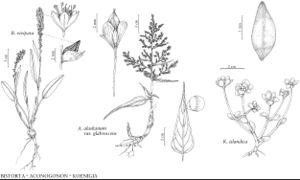Aconogonon
Handb. Nat. Pfl.-Syst., 236. 1837.
| Taxon | Illustrator ⠉ | |
|---|---|---|
 | Bistorta vivipara Aconogonon alaskanum var. glabrescens Koenigia islandica | Yevonn Wilson-Ramsey Yevonn Wilson-Ramsey Yevonn Wilson-Ramsey |
Herbs, perennial; roots woody. Stems ascending to erect, glabrous or pubescent to pilose or tomentose. Leaves deciduous, mostly cauline, alternate, petiolate or sessile; ocrea persistent or deciduous, chartaceous; blade narrowly lanceolate to ovate, margins entire, sometimes irregularly undulate. Inflorescences terminal, subterminal, or axillary, racemelike or paniclelike; peduncle present or essentially absent. Pedicels present. Flowers bisexual, 1–5 per ocreate fascicle, base stipelike or not; perianth nonaccrescent, creamy or greenish to yellowish white or pink, rotate, glabrous; tepals 5, connate ca. 1/4 their length, petaloid, slightly to distinctly dimorphic, outer 2 smaller than inner 3; stamens 8; filaments distinct, free or adnate to perianth-tube, glabrous; anthers yellow to pink or reddish purple, ovate to elliptic; styles 3, erect or spreading, distinct or connate proximally; stigmas capitate. Achenes includedor exserted, yellowish or dark-brown, unwinged, 3-gonous, glabrous. Seeds: embryo usually curved. x = 8, 10, 11.
Distribution
w North America, Europe, Asia
Discussion
Species ca. 25 (3 in the flora).
The orthography of and author citation for the genus name have been matters of confusion. Meisner published the taxon as Polygonum sect. Aconogonon. Reichenbach elevated it to generic rank and changed the orthography, apparently deliberately, to Aconogonum. Debate centers on whether Reichenbach’s name is new (Aconogonum Reichenbach) or should be treated as Meisner’s section name elevated to generic rank [Aconogonon (Meisner) Reichenbach]. Following established custom, we here use Aconogonon.
Aconogonon often is treated as a section of Persicaria (L.-P. Ronse Decraene and J. R. Akeroyd 1988); pollen morphology, inflorescence type, and seed and stem anatomy have been used by some taxonomists for segregation at the generic level (K. Haraldson 1978; Hong S. P. 1991).
Aconogonon campanulatum (Hooker f.) H. Hara is planted as an ornamental. C. L. Hitchcock and A. Cronquist (1973) reported it as escaping and probably established west of the Cascade Mountains, especially in Seattle, Washington. P. Zika (pers. comm.) searched numerous herbaria in the Pacific Northwest. He found no voucher indicating that A. campanulatum has escaped there, although it is cultivated occasionally in the Seattle area; it therefore is excluded here.
Selected References
Key
| 1 | Inflorescences axillary, racemelike; plants 12-42(-50) cm; leaf blades oblong-ovate to ovate, rarely broadly lanceolate, 2.1-7.5(-9.7) × 1.1-5 cm, often glaucous | Aconogonon davisiae |
| 1 | Inflorescences usually terminal or subterminal, sometimes also axillary, paniclelike; plants (30-)50-150(-200) cm; leaf blades narrowly lanceolate to ovate, 5-20 × 1.4-8 cm, not glaucous | > 2 |
| 2 | Achenes 2.6-3.8 mm, included or exserted, tan to grayish, faces usually not concave; inflorescences terminal, sometimes also axillary; Alaska, n Yukon, nw Northwest Territories | Aconogonon alaskanum |
| 2 | Achenes (3-)3.8-7 mm, usually exserted, yellowish brown, faces concave; inflorescences usually terminal, subterminal, and axillary; n California, Oregon, Washington, Idaho, w Montana, n Nevada | Aconogonon phytolaccifolium |
"/2" is not declared as a valid unit of measurement for this property.